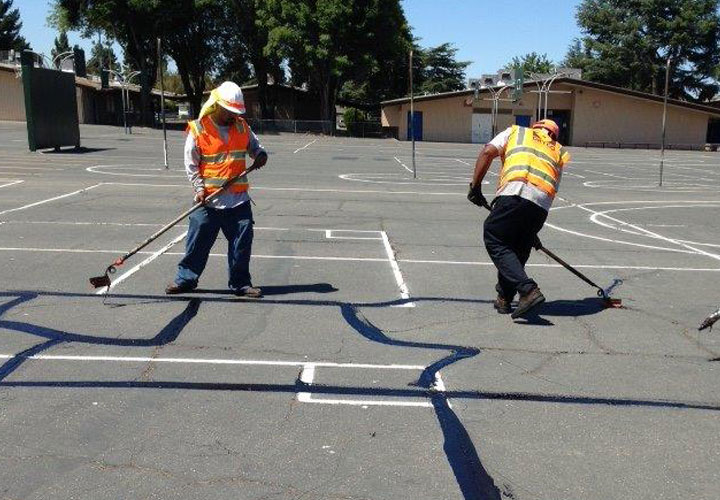Swift Solutions for Asphalt Spot Repair: Optimum Securing Strategies
Swift Solutions for Asphalt Spot Repair: Optimum Securing Strategies
Blog Article
Cold Mix Asphalt Vs. Hot Mix Asphalt: Which Is Right for You?

Structure Distinctions
Cold mix and hot mix asphalts vary considerably in their make-up, with distinct attributes that influence their performance and applications. Cold mix asphalt is created by emulsifying the asphalt binder with water and an emulsifying representative before mixing it with aggregate. This approach permits the asphalt to be convenient at lower temperature levels, making it suitable for short-term repairs and for usage in cooler weather. Warm mix asphalt, on the other hand, is produced at heats, generally between 300-350 ° F, which helps to achieve much better compaction and an extra durable end product. The warm mix asphalt production process involves warming the accumulation and asphalt binder independently before combining them at the asphalt plant.
Additionally, cold mix asphalt has a tendency to be much less thick and extra adaptable than warm mix asphalt. This adaptability makes it far better suited for locations with higher levels of movement, such as driveways or roadways with rush hour. In contrast, hot mix asphalt is known for its high resilience and resistance to rutting and breaking, making it a preferred choice for highways and high-traffic roads where longevity is essential.
Installation Process Variations
The process of installing chilly mix and warm mix asphalt displays notable differences in their procedures and demands. In comparison, hot mix asphalt requires an extra elaborate setup procedure. Due to the heating requirements, hot mix asphalt installments are usually lugged out by specialists with specific equipment, making certain a more long-term and structurally audio result.
Longevity and Longevity Elements
When thinking about asphalt options, resilience and longevity are crucial factors to review for enduring pavement efficiency. Warm mix asphalt (HMA) is known for its extraordinary resilience and longevity.
In regards to longevity, HMA typically outmatches CMA because of its superior toughness and resistance properties. HMA sidewalks have a longer service life, calling for less constant repair services and maintenance, which can convert see post to set you back savings in the future. Furthermore, HMA pavements are a lot more easily personalized to meet details project needs, additionally boosting their sturdiness.
Price Considerations
Considering the financial implications is an a knockout post essential aspect when assessing the option between hot mix asphalt (HMA) and chilly mix asphalt (CMA) for pavement jobs. While the first expense of warm mix asphalt is normally greater than that of chilly mix asphalt, HMA commonly supplies a much more economical option in the long run due to its exceptional sturdiness and durability.
Along with material costs, it's vital to think about the expenses connected with installation and upkeep when contrasting HMA and CMA. HMA normally needs specific equipment and skilled labor for correct installment, which can affect general project prices. Alternatively, CMA is much easier to work with and can typically be applied making use of easier methods, possibly reducing installation expenditures. Eventually, the choice between HMA and CMA need to take right into account not just the initial price however also here are the findings the lasting economic effects to establish the most cost-effective choice for the details pavement task.
Environmental Effect Contrast
Contrast of the environmental effects in between hot mix asphalt (HMA) and chilly mix asphalt (CMA) discloses distinct differences in sustainability methods. HMA manufacturing requires heats, leading to enhanced power intake and greenhouse gas emissions. The process likewise launches volatile organic compounds (VOCs) and harmful air pollutants (HAPs) into the environment. In comparison, CMA is produced and applied at reduced temperature levels, reducing energy usage and discharges considerably. The lower manufacturing temperature levels of CMA result in decreased fuel usage and lower degrees of carbon dioxide emissions, making it a more eco-friendly choice.
Moreover, the use of CMA typically involves reusing existing asphalt pavement, advertising resource conservation and lowering the amount of waste sent to land fills. By opting for CMA over HMA, roadway building projects can add positively to environmental conservation initiatives.
Final Thought
In final thought, the selection between cool mix asphalt (CMA) and hot mix asphalt (HMA) depends upon various aspects such as composition, setup procedure, longevity, longevity, expense, and ecological impact. angle parking. While CMA offers a economical and fast service for minor fixings, HMA guarantees remarkable durability and longevity for heavy website traffic areas. Think about these aspects meticulously to establish which kind of asphalt is the appropriate choice for your paving needs

Considering the financial ramifications is an essential facet when evaluating the option in between hot mix asphalt (HMA) and chilly mix asphalt (CMA) for sidewalk projects. While the preliminary expense of hot mix asphalt is commonly higher than that of chilly mix asphalt, HMA usually provides a much more cost-effective service in the lengthy run due to its premium resilience and longevity. asphalt repair.Comparison of the environmental effects in between warm mix asphalt (HMA) and cool mix asphalt (CMA) reveals distinct differences in sustainability techniques.In verdict, the option in between cold mix asphalt (CMA) and hot mix asphalt (HMA) depends on various aspects such as make-up, installment procedure, resilience, durability, expense, and environmental effect
Report this page